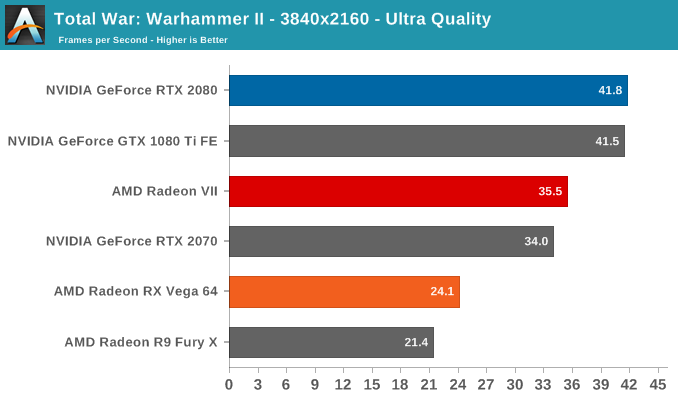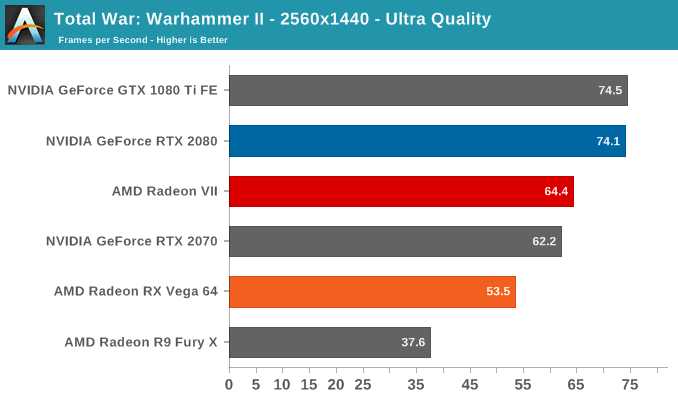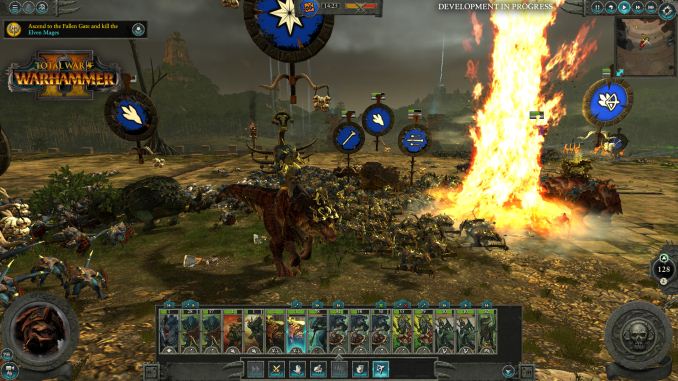The AMD Radeon VII Review: An Unexpected Shot At The High-End
by Nate Oh on February 7, 2019 9:00 AM ESTTotal War: Warhammer II (DX11)
Last in our 2018 game suite is Total War: Warhammer II, built on the same engine of Total War: Warhammer. While there is a more recent Total War title, Total War Saga: Thrones of Britannia, that game was built on the 32-bit version of the engine. The first TW: Warhammer was a DX11 game was to some extent developed with DX12 in mind, with preview builds showcasing DX12 performance. In Warhammer II, the matter, however, appears to have been dropped, with DX12 mode still marked as beta, but also featuring performance regression for both vendors.
It's unfortunate because Creative Assembly themselves have acknowledged the CPU-bound nature of their games, and with re-use of game engines as spin-offs, DX12 optimization would have continued to provide benefits, especially if the future of graphics in RTS-type games will lean towards low-level APIs.
There are now three benchmarks with varying graphics and processor loads; we've opted for the Battle benchmark, which appears to be the most graphics-bound.



Wrapping things up for games is Total War: Warhammer II, and this title is one that is less than ideal for the matchup between the Radeon VII and its competitors. Much like GTA V, the card is able to make substantial improvements over its predecessor; at 4K, this is an astounding 47% increase over the RX Vega 64. Nevertheless, given the starting point of the RX Vega 64, the Radeon VII is still somewhere around 15% behind the reference RTX 2080, meaning that it performs a shade faster than the reference RTX 2070 at 4K/1440p. That's not where the Radeon VII ideally wants to be, despite being respectable way to iterate on the RX Vega 64.











289 Comments
View All Comments
zodiacfml - Friday, February 8, 2019 - link
The first part of your conclusion describes what this product is. It is surprising to see this card's existence at 7nm, a Vega with 16GB of HBM2.It appears to me that AMD/TSMC is learning the 7nm process for GPUs/CPUs and the few chips they produce be sold as a high end part (as the volume/yields is being improved).
AMD really shot high with its power consumption (clocks) and memory to reach the pricing of the GTX 2080.
However, I haven't seen a publisher to show undervolting results. Most Vegas perform better with this tweak.
Samus - Saturday, February 9, 2019 - link
I think you are being a little too critical of this card. Considering it’s an older architecture, it’s impressive it’s in the 2080’s ballpark.And for those like me that only care about Frostbite Engin based games, this card is obviously a better option between the two cards at the same price.
You also ignored the overclockong potential of the headroom given by moving to 7nm
D. Lister - Saturday, February 9, 2019 - link
"You also ignored the overclockong potential of the headroom given by moving to 7nm"Unfortunately it seems to be already overclocked to the max on the core. VRAM has some headroom but another couple of hundred MHz isn't going to do wonders considering the already exorbitant amount available.
D. Lister - Saturday, February 9, 2019 - link
*...considering the already exorbitant amount [of bandwidth] available.Oxford Guy - Saturday, February 9, 2019 - link
"I think you are being a little too critical of this card."Unless someone can take advantage of the non-gaming aspects of it, it is dead in the water at the current price point. There is zero reason to purchase a card, for gaming only, that uses more power and creates vastly more noise at the same price point of one that is much more efficient for gaming purposes. And, the only way to tame the noise problem is to either massively undervolt it or give it water. Proponents of this GPU are going to have to show that it's possible to buy a 3 slot model and massively undervolt it to get noise under control with air. Otherwise, the claim is vaporware.
Remember this information? Fiji: 596 mm2 for $650. Vega 10 495 mm2 for $500. Vega 20 331 mm2 for $700.
Yes, the 16 GB of RAM costs AMD money but it's irrelevant for gaming. AMD not only gave the community nearly 600 mm2 of chip it paired it with an AIO to tame the noise. All the talk from Su about improving AMD's margins seems to be something that gamers need to stop lauding AMD about and starting thinking critically about. If a company only has an inferior product to offer and wants to improve margins that's going to require that buyers be particularly foolish.
Samus - Sunday, February 10, 2019 - link
I wouldn't call the 16GB irrelevant. It trumps the 2080 in the two most demanding 4K titles, and comes relatively close in other ultra high resolution benchmarks.It could be assumed that's a sign of things to come as resolutions continue to increase.
Oxford Guy - Sunday, February 10, 2019 - link
"It could be assumed that's a sign of things to come as resolutions continue to increase."Developers adapt to Nvidia, not to AMD. That appears to be why, for instance, the visuals in Witcher 3 were watered-down at the last minute — to fit the VRAM of the then standard 970. Particularly in the context of VRAMgate there was an incentive on the part of Nvidia to be certain that the 970's VRAM would be able to handle a game like that one.
AMD could switch all of its discreet cards to 32 GB tomorrow and no developers would bite unless AMD pays them to, which means a paucity of usefulness of that 32 GB.
BenSkywalker - Saturday, February 9, 2019 - link
This offering is truly a milestone in engineering.The Radeon VII has none of the RTX or tensor cores of the competition, uses markedly more power *and* is built with a half node process advantage and still, inexplicably, is slower than their direct competitor?
I've gone back and looked, I can't find another example that's close to this.
Either TSMC has *massive* problems with 7 nm or AMD has redefined terrible engineering in this segment. One of those, at least, has to be at play here.
Oxford Guy - Saturday, February 9, 2019 - link
The RTX and Tensor die area may help with power dissipation when it's shut down, in terms of hot spot reduction for instance. Vega 20 is only 331 mm2. However, it does seem clear enough that Fiji/Vega is only to be considered a gaming-centric architecture in the context of developers creating engines that take advantage of it, à la DOOM.Since developers don't have an incentive to do that (even DOOM's engine is apparently a one-off), here we are with what looks like a card designed for compute and given to gamers as an expensive and excessively loud afterthought.
Oxford Guy - Saturday, February 9, 2019 - link
There is also the issue of blasting clocks to compensate for the small die. Rip out all of the irrelevant bits and add more gaming hardware. Drop the VRAM to 8 GB. Make a few small tweaks to improve efficiency rather than just shrink Vega. With those things done I wonder how much better the efficiency/performance would be.